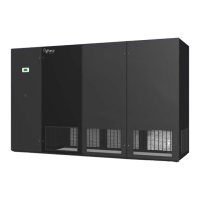32
6 GLYCOL SYSTEMS
6.1 Glycol Concentration
The system must be lled with water and the appropriate amount of glycol (either ethylene or propylene)
to protect against winter freeze-up. To achieve the approximate glycol concentration, it is necessary to
know the total system volume. This consists of the sum of the uid cooler volume, the evaporator unit
volume and the volume of the inter-connecting piping.
The following tables can be used for arriving at an approximate system volume. After installation,
the glycol percentage should be checked. The glycol percentage should also be checked at regular
intervals to ensure freeze protection.
6.2 Internal (Fluid) Volume – Up and Downow Evaporators
Evaporator Model Standard Unit Volume In
Gallons (Liters)
Energy Saver Unit Volume In
Gallons (Liters)
GTGD 021 4.0 (15.1) 8.2 (31.0)
GTGD 028 4.5 (17.0) 8.7 (32.9)
GTGD 035 5.0 (18.9) 9.2 (34.8)
GTGD 046 5.5 (20.8) 9.7 (36.7)
GTGD 056 7.5 (28.4) 15.9 (60.2)
GTGD 070 8.0 (30.3) 16.8 (63.6)
GTGD 091 10.0 (37.9) 16.3 (61.7)
GTGD 106 12.0 (45.4) 23.1 (87.4)
6.2.1 Brazed-Plate Condensers
Data Aire water cooled units use brazed-plate condensers as a standard. Brazed-plate condensers
are constructed of plates brazed together to form an assembly of separate channels. Refrigerant is
conned to the space between the welded plates and is exposed to gaskets only at the ports. Such
condensers have a higher range of capacity.
The stainless steel plates are congured with a wave pattern, which results in high turbulence and low
susceptibility to fouling. Because of the compact design, these condensers requires a low refrigerant
charge. The construction of brazed units does not allow mechanical cleaning, and internal leaks usually
cannot be repaired. Thus, it is recommended to use closed-loop cooling systems with good ltration or
separators to keep the water clean.
Note: Data Aire does not have experience of in-depth knowledge in the eld of water
treatment and therefore only provides the following information as a general reference.
To properly maintain your water system, please consult a water treatment expert.
6.2.1.1 Water Treatment
If impurities are not controlled, they can cause sludge or biological fouling. Simple blowdown (discharging
a small portion of the recirculating water to a drain) may be adequate to control scale and corrosion on
sites with good-quality makeup water, but it does not control biological contaminants such as Legionella.
Chapter 49 of the ASHRAE Handbook—HVAC Applications covers water treatment in more detail.
Specic recommendations on water treatment can be obtained from water treatment suppliers.

